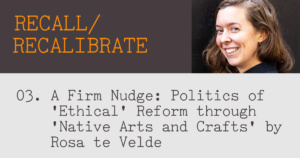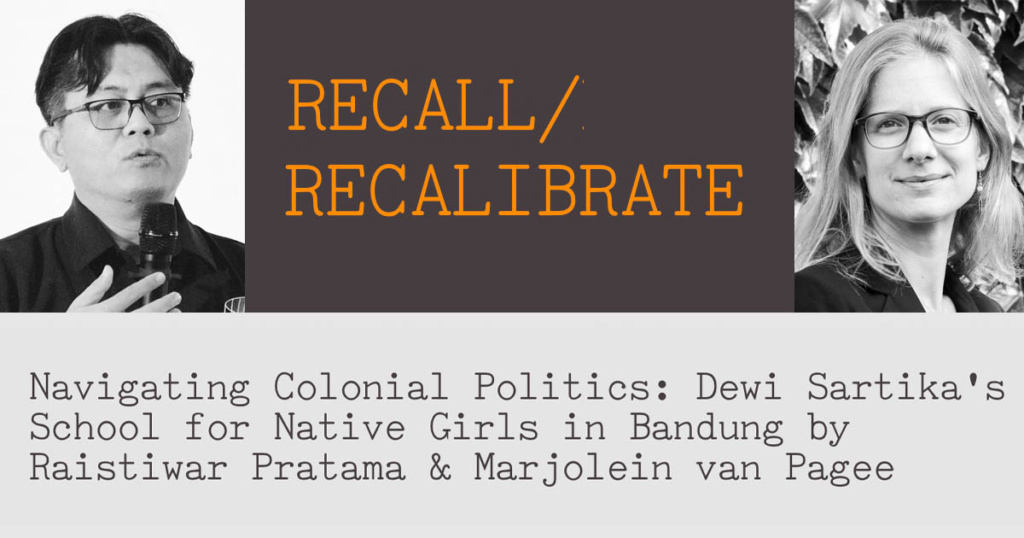‘Dangerous Competitors’
The Dutch Ethical Policy (1901) and the Establishment of Craft Schools in East Java

This essay is part of the newly launched ‘Recall/Recalibrate‘ project, which critically investigates the so-called ‘ethical policy’ that the Dutch had implemented at the turn of the twentieth century in Dutch-occupied Indonesia. The project is an initiative of Dutch design educator Rosa te Velde. In this text, Dutch historian Marjolein van Pagee focuses on the establishment of craft schools in Dutch-occupied Indonesia. The Dutch Ethical Policy formally promised to improve the welfare of Indonesians through education, the question is, however, whether Indonesians actually profited from it. Van Pagee shows how the racist apartheid system was a leading factor in the decision-making process on who received education or not. The colonial motivation behind crafts education was also to create a (limited) indigenous labour force that primarily served the interest of the colonial capitalist system.
www.recalibrate.nl, 17 August 2025, text: Marjolein van Pagee, download as PDF ![]()

In 1905, Christiaan Snouck Hurgronje, a famous Dutch orientalist and colonial advisor, rejected the colonial regime’s proposal to provide education to the Indonesian population en masse. He referred to indigenous people as ‘childish’ and ‘immature’, and believed there was no substantial desire for formal education. He thought the proposal to set up craft schools was ridiculous, and considered ‘what remained’ of Indonesian cultures[1] too insignificant to be worth investing in.[2]
In 1901, the Dutch colonial regime formally implemented the so-called Ethical Policy, with education as one of its pillars. This ‘ethical’ branch of colonialism was based on the idea that the colonisers had a moral obligation to ‘give something back’ to the colonised. Not only were the objectives of the policy very limited – and never fully realised – it was also a poorly disguised form of white saviourism. It was strongly opposed at the time by conservatives who considered it wholly unnecessary to attempt to improve the conditions of colonised people. This disagreement between ‘ethicists’ and conservatives led to endless discussions among the Dutch colonial elite at the turn of the twentieth century, grappling with questions of education in terms of both profitability and necessity.
In the nineteenth century, the colonial regime only provided primary education for the children of local aristocrats – the indigenous elite.[3] Although the Ethical Policy brought some change in that regard, as more schools for regular non-aristocrat Indonesians were built, the results were not drastic enough; education for the indigenous elite was still the priority. Between 1900 and 1940, the number of Indonesians who received primary education increased from 98,000 to 2,1 million.[4] But as Francisca Pattipilohy, an Indonesian 1965-exile in Amsterdam, writes:
Despite all ethical ideals, the majority of the Indonesian population was still illiterate in 1942, only 6 percent could read and write. Of the small group of Indonesians who were allowed to go to school, only a handful were admitted to higher education. With a population of (then) 70 million people, this is nothing.[5]
Primary education was only about very basic skills, taught in Malay language, the precursor to contemporary Indonesian. As craft students were expected to have finished primary education, which was lacking in general, craft schools were attended by an even smaller percentage of the indigenous population.[6]
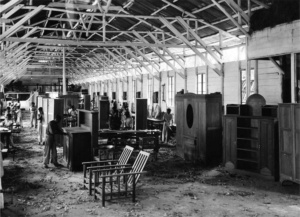
‘Crafts education’ can be translated to Dutch as ambachtsonderwijs or nijverheidsonderwijs, which were a form of secondary education. In the Dutch language, the terms ambacht and nijverheid are often used interchangeably. In some cases, the terms describe a form of technical training that prepared students for industrial jobs, while in other cases they imply the learning of ‘home crafts’. It seems that the latter distinction also relates to the differences in interest between coloniser and colonised. For example, at indigenous craft schools, students were trained in traditional wood-cutting techniques, pottery making, and weaving, and the training was meant to make indigenous farmers less dependent on peasantry alone as income. The government-supported ambachtsscholen provided training in carpentry and metalworking in order to increase the number of skilled workers who could take technical jobs in one of the colonial industries. Art education was not a matter of concern until the 1920s.[7] In any case, mostly economic motives such as profitability determined whether or not a school was granted government funding.
But in the capitalist-driven economy of Dutch-occupied Indonesia, there was also a three-tiered apartheid system in place. How did existing racial hierarchies influence the decision-making process of the colonial regime in terms of crafts education? To put it differently: which groups were considered valuable enough for the colonisers to invest in? This essay will examine how both economic and racist motivations together influenced the establishment of craft schools in East Java in early 1900.
Three-tiered apartheid system
Similar to other European colonies, Dutch-occupied Indonesia was a world ‘cut in two’, as Frantz Fanon put it in The Wretched of the Earth.[8] In the colonial setting, white men were solely directors and managers, walking around in spotless white suits, ordering around brown people. Since white people in Dutch-occupied Indonesia would never do factory work, a small group of trained brown workers was needed.
The world ‘cut in two’ was sustained by a three-tiered apartheid system, in which Europeans and legally assimilated Indo-Europeans formed the top layer.[9] Within this group, the whites enjoyed the most powerful positions in comparison to mixed-race people, whose light-brown skin was still considered inferior. A little lower on the racist ladder were Chinese people, Arabs, and people from India, who were referred to as ‘vreemde oosterlingen’ (foreign orientals), forming the colonial middle class.[10]
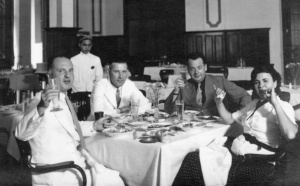
The lowest category, derogatorily referred to as ‘inlanders’ (natives), consisted of the various ethnic groups belonging to the Indonesian archipelago. Needless to say, this group was looked down upon by the whites, and often too by the sub-groups ranked above them. Indonesians were refused access to European restaurants and swimming pools, for example by signs that read: ‘forbidden for dogs and natives’. Indonesians were also required to sit in separate compartments in trains and trams. Government and other official buildings had separate restrooms for native people.[11] In terms of criminal law, this segregation also meant that Indonesian people received much harsher sentences than Europeans. After the Netherlands first abolished capital punishment in 1870, colonial courts continued to serve death penalties to Indonesian convicts.[12]
The particular way that the legal system dealt with people of mixed Indo-European descent led to remarkable contradictions. Someone could be brown and still enjoy the highest ‘European’ status. Conversely, someone could be light-skinned or even blonde-haired, but still be counted as ‘native’ in case the father had not recognised the child. Apart from legal status, someone’s acceptance to the European class was also linked to cultural traits and linguistic abilities.
The Europeanisation of mixed-race Indo-European people
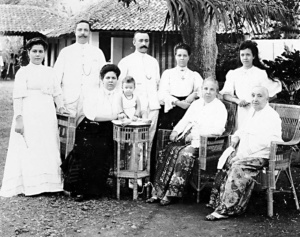
In the second half of the nineteenth century, when the apartheid system was still being developed, impoverished mixed-race Indo-Europeans were encouraged to embrace their Dutch heritage and become Europeans. In many cases they were abandoned by their European fathers – who left for Europe – and taken away from their indigenous mothers in the villages.[13] The colonial upper class found it a disgrace for their prestige that those with European ancestry were as poor and uneducated as the lowest class of the apartheid system.[14] Not only were they granted the highest legal status but they were also sent to school.
This is the context in which, in 1853, a group of wealthy individuals in Surabaya took the initiative to set up a craft school (ambachtsschool) for ‘children of the lower classes born here [in the Dutch East Indies] from Christian parents’. Notably, the school was also part of an orphanage, though the children were often not orphans in the literal sense. The idea was that, by financially supporting those with European ancestry, and teaching them practical skills such as carpentry, Indo-Europeans could be turned into a useful middle class. In order to become ‘fully Dutch’, they were forced to abandon their maternal indigenous culture, language, and religion, and embrace Dutch colonial (Christian) culture instead.
In this period, growing industrial activity saw an increased need for labour, and Dutch colonial rulers regarded Indo-European people as the main source of potential workers before they turned their attention to indigenous people. Most Muslim Javanese people had suffered greatly under the exploitative ‘Cultivation System’[15] that existed between 1830 and 1870, and continued to live as poor peasants. Unlike mixed-race Indo-Europeans, there was nothing to help them to climb up the social – and very material – ladder, as throughout the 1800s, before the ‘ethical’ branch of colonialism was born, no colonial policy promoted practical education for regular (non-aristocrat) indigenous people.
This changed at the turn of the twentieth century when the Europeanisation of mixed-race people was considered a failure.[16] Only then did colonial ethicists begin to plead for the establishment of indigenous craft schools, separate from the (Indo-)European institutions. They knew they needed to further expand their potential labour force, but before concrete steps were taken, the colonial leadership had to be convinced of the necessity.
A sharp distinction
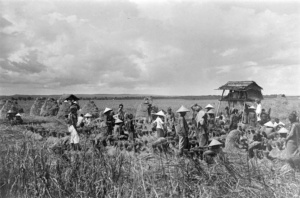
In 1903, the Ministry of Colonies in The Hague ordered a series of inquiries to determine whether educational reforms were needed. In his report, Dutch Member of Parliament Dirk Fock, a famous ethicist who would later become Governor-General, emphasised that the financial and intellectual condition of Indonesians was incomparable with the ‘level of development achieved by Western industry after centuries of study and hard work’. He spoke of a ‘sharp distinction’ between local Indonesian and European industries, which required the direct rule of ‘Western capital and intellect’. [17]
Fock argued that indigenous people could only be subordinate labourers: ‘they cannot be the boss, nor the administrator’. Regarding more technical jobs, for which chemical and mechanical knowledge was required, Fock believed these areas of industry were so advanced that Indonesian workers would not be capable of contributing, due to a general lack of development.[18]
J.E. Jasper’s research in Surabaya
Apparently, the aforementioned series of inquiries were not convincing enough. In December 1905, the Indo-European civil servant J. E. Jasper was ordered to carry out an additional investigation in his hometown, Surabaya. As Indonesia’s second largest city and capital of the province East Java, Surabaya was a flourishing industrial town in early 1900, surrounded by tobacco and sugar fields. In December 1905, an unknown author in Soerabaiasch Nieuwsblad deemed Jasper’s assignment completely redundant: ‘Now, the question is asked whether the expansion of native education is desirable! Tomorrow we will be asked whether it is desirable for natives to eat,’ he wrote mockingly.[19]
Unsurprisingly, Jasper, who submitted his findings in April 1906, came to the conclusion that the level of colonial education for the indigenous population was insufficient. His entire third chapter dealt specifically with indigenous craft schools.[20] One of his suggestions was to set up mobile schools in villages to reach remote areas as well. But Governor-General Van Heutsz, together with the Raad van Nederlandsch-Indië (the Dutch East Indies Council), only wanted to support one trial school in Surabaya. He warned of ‘exaggeration’ as the job market on Java did not need so many trained Javanese people. He referred to the colonial industry as ‘a purely European matter’. On one hand, he acknowledged the need for more practical education for a minority of native students, but on the other hand, he believed that the majority of indigenous society did not want to be educated, and would remain farmers and fishermen. In any case, he argued, the colonial regime did not have sufficient means to provide education for all.[21]
The Council of white colonial men went so far as to say that it would be unfair if the colonial government would build schools that most Javanese did not want, while the average ‘little man’ had to pay for it.[22] (Through taxes? [23]) With their reasoning, they basically reversed the problem: it was not the lack of education but the spending of money on education that was presented as unjust.
Eventually, in 1909 and 1910, three craft schools were realised in Surabaya, Semarang, and the colonial city of Batavia (now Jakarta).[24] The idea of additional mobile schools never materialised.[25] The reluctance of the colonial regime to support indigenous craft schools was based on an economic concern. Indigenous people were seen as ‘dangerous competitors’ for the European job market, as they accepted lower wages than (Indo-) Europeans. In 1901, a piece signed with the initial ‘Z’, posed the following question:
‘Which decent European craftsman will allow himself to teach a well-educated native boy, for a certain salary, about the secrets of his profession? Knowing that within a few years the boy will be a dangerous competitor? […] A European craftsman now ensures that his native workers do not become too smart and therefore won’t pose a risk of significant competition’.[26]
The Freemason craft school in Surabaya
In 1898, the Freemasonry Lodge ‘De Vriendschap’ in Surabaya initiated the replacement of the old craft school of 1853, as the latter was only an evening school. Unlike the separate craft school for indigenous people that the colonial regime was about to set up in 1909 (following Jasper’s inquiry), this ambachtsschool provided technical education exclusively for (Indo-)Europeans.[27]
The relationship between the Freemasons – often wealthy white men – and European-led businesses in Indonesia was very tight. If members did not hold high positions in the colonial government or army, they worked as directors and managers in one of the many colonial companies. Together, they provided funds, a plot of land, and even materials for the schools. The Dutch colonial firm Van de Linde Teves, for instance, provided the school with free carpentry tools.[28]
Moreover, their ideals regarding charity also overlapped with some aspects of the Ethical Policy.[29] Dutch researcher Theo Stevens, in his study on Freemasonry in Dutch-occupied Indonesia, explains that from 1900 onwards, the lodges started to use their resources in favor of Indo-Europeans ‘for whose fate they increasingly felt responsible’. He admits that, although on paper they were concerned about the fate of Indonesians, the scale at which these self-renowned ‘do-gooders’ actually did something for indigenous people remained extremely limited.[30]
Utoyo’s craft school in Ngawi
Due to the limited efforts of the colonial entity to provide education for all, indigenous people sometimes took matters into their own hands. An often-cited example of this is the craft school in the East Javanese town of Ngawi, which was an initiative of the young Javanese aristocrat Raden Mas Tumenggung Utoyo,[31] who was the regent of Ngawi between 1902 and 1905. As an inspector for the colonial regime, Jasper became involved in the project and eventually took it over, sidelining Utoyo.[32] Schools established by indigenous Indonesians were referred to as wilde scholen (wild schools) and faced a lot of opposition. Although Utoyo was an aristocrat and part of the collaborating local elite who mastered the Dutch language, the school that he set up did not enjoy the advantage of having rich financial backers and high-ranking supporters within the system.
The story began in July 1902, before the government investigations were carried out, when Utoyo published an article in Tijdschrift voor het Binnenlandsch Bestuur (Journal for Domestic Administration) in which he advocated for the establishment of subsidised craft schools for the native population. In fact, Jasper’s report of 1906, in which he advocated for the building of mobile-home schools in remote villages, was based on Utoyo’s proposal. The colonial regime granted Utoyo 2,270 guilders and referred to the project as ‘an experiment’. Unlike the technical craft school in Surabaya, Utoyo did not want to prepare students for industrial jobs. He wanted peasants to learn additional skills in home craft in order to increase their incomes by selling the products they produced.[33]
At first, following Utoyo’s plan, five separate schools were set up in the region, with one main school at the centre. The idea was that teachers could travel between the different locations to provide courses in wood and bamboo processing, furniture making, and wickerwork. For unclear reasons, a shortage of budget perhaps, the five locations were soon closed; the trial ended not even a year after it was started. After this, the colonial regime ordered Jasper and his colleague Bertsch to take over the project and set up one central school in Ngawi. Now, the peasant students from the country-side had to travel to the city to be able to attend classes.[34]
Often, when the history of crafts education in Dutch-occupied Indonesia is discussed, the Ngawi school is mentioned as a positive example. Unfortunately, not much is known about the man behind it. How did Utoyo feel about the forced closure of the school in 1904? Was he disappointed, or frustrated perhaps, about the lack of funding that he received? Did he know about the report that Jasper completed in 1906, which included his ideas?
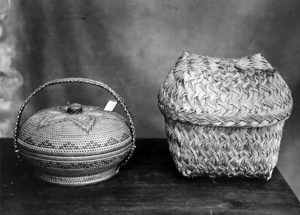
We do know that Utoyo was succeeded by a man named Sosro Boesono in 1905. After the craft school was reopened under the supervision of the colonial government, Boesono submitted annual reports to his superiors. Based on his reports, kept in the Dutch National Archives, we know that the school earned some money by selling the products produced by the students. Twenty percent of the revenues was paid directly to the students, and many of them received awards at the annual fairs in Surabaya and Semarang. They made cookware of good enough quality to be used in the kitchen, along with glass covers and other items of horn, turtle, and shells. They also learned how to make other practical products like seat mats and cigar sleeves. The number of students varied between fifty and sixty, of which only a small minority came from an aristocratic background. The school had teachers specialising in wood cutting, drawing, weaving, and the processing of horn. To be accepted for enrolment on the two-year course, students had to be able to read, write, and know some basic mathematics as well, and they could not be older than twenty years of age.
Apparently, according to Boesono’s report, thirteen students dropped out, for a variety of reasons. One had to quit because he had to help his parents, two others had found jobs, four got sick, and five students were not competent enough to continue. For some, money was a barrier. In the year 1907, the Dutch colonial regime paid the twelve poorest students a compensation of 2,50 guilders per month, but reduced their percentage of sales revenue from 20% to 10%. In 1908, some students were forced to borrow money to be able to pay for their tuition, because the colonial regime had not transferred the annual allowance that they had promised. It turned out that the Dutch esident[35] of Madiun ‘forgot’ to request it from the Ministry of Education, even though he had received several letters from the school in Ngawi requesting the students’ allowance. In their report, Bertsch and Jasper assured the government that the allowance would not be needed from 1910 onwards, as they believed the school would sell enough items to support those students that could not afford the tuition.
For Dutch colonial ethicists, like Jasper and Fock, the Ngawi school was a positive experiment that deserved encouragement. In the Netherlands, in his role as Minister of Colonies, Conrad Theodor Van Deventer, known for his pamphlet ‘Een Eereschuld’ (A Debt of Honour, 1899) advocated for the establishment of more native craft schools, referring to Ngawi as a good example. But colonial hardliners were less positive and deemed native craft schools ‘a waste of money’. The Dutch resident of Madiun even advised the closure of the Ngawi school. In 1911, another inspector emphasised that the people of Ngawi did not deserve a craft school because they were lazy: ‘they don’t want to work, not more than necessary to survive’. [36]
Conclusion
At first sight, Dutch colonial ethicists promoting indigenous craft schools may appear as more open-minded in comparison to conservative hardliners who opposed this kind of educational provision. However, both ‘branches’ of colonialism were equally racist in the way they accepted the apartheid system without question. They all used economically driven, capitalist markers such as profitability to determine the usefulness of crafts education. Although Utoyo’s school in Ngawi was praised as a promising example, it was first closed and subsequently taken over by colonial administrators. Apparently, ethicists and conservatives alike were against indigenous autonomy, presumably because ‘wild schools’ posed a threat to the colonial system of control. Hence, crafts education for indigenous people was only allowed under strict European leadership. The latter enforced white saviourism, or, in the case of an Indo-European like Jasper, ‘light-brown saviourism’. The deliberate limitation of crafts education for Indonesians intended to prevent them becoming ‘dangerous competitors’ to their (Indo-) European peers. It was the apartheid system that placed mixed-race Indo-Europeans and indigenous Indonesians into competition with one another, in a very unequal struggle for emancipation. Within the racist context of Dutch- occupied Indonesia, it was much easier to set up a craft school for (Indo)-Europeans than a school for indigenous students. Indo-Europeans were equally racialised and rejected if they were not Dutch or European ‘enough’, but their European lineage could be emphasised and instrumentalised in a way that could never apply to indigenous Indonesians.
In conclusion, the history of craft schools in Dutch-occupied Indonesia cannot be properly understood without acknowledging the three-tiered apartheid system that was so ingrained at the time, and that always placed indigenous Indonesians at the very bottom.
End Notes:
[1] It is no surprise that European colonisers like Snouck Hurgronje never acknowledged that the oppressive nature of their rule was the essential obstacle to the free development of indigenous cultural expressions. This was not only the case with arts and crafts – Dutch colonial rule also destroyed various pre-colonial trade networks. As Indonesia’s first president Sukarno put it in 1930, when he was defending himself in court after the Dutch colonial regime arrested him: ‘The imperialist system has, since the time of the [Dutch East India] Company, eradicated every enterprise of significance for the people, by its roots, and hindered every growth of indigenous businesses, so that no crafts or any Indonesian industry could flourish anymore.’ See: Soekarno, Indonesië klaagt aan!: pleitrede voor den landraad te Bandoeng op 2 December 1930, Amsterdam, Arbeiderspers, 1931, p. 77.
[2] As cited in: M. Bloembergen, Koloniale vertoningen: de verbeelding van Nederlands-Indië op de wereldtentoonstellingen (1880-1931), PhD diss., University of Amsterdam, 2001, p. 201; or: De koloniale vertoning. Nederland en Indië op de wereldtentoonstellingen (1880–1931), Amsterdam, Wereldbibliotheek, 2002, p. 249.
[3] A. Surjomihardjo, ‘National Education in a Colonial Society’, in Haryati Soebadio and Carine A. du Marchie Sarvaas (eds.), Dynamics of Indonesian History, Amsterdam, Elsevier Science, 1978, p. 277.
[4] P. Hagen, Koloniale oorlogen in Indonesië. Vijf eeuwen verzet tegen vreemde overheersing, Amsterdam, De Arbeiderspers, 2018, p. 514-515.
[5] F. Pattipilohy, ‘Voorwoord’, in M. van Pagee, Banda. De genocide van Jan Pieterszoon Coen, Utrecht, Omniboek, 2021, p. 9-10.
[6] Sons of aristocratic families could be admitted to European schools for secondary education, provided that they were fluent in Dutch. Most of them became civil servants, teachers, or doctors. In 1898, the School tot Opleiding van Inlandsche Artsen (School for the Training of Native Doctors, STOVIA) was established. Followed in 1920 with the Technische Hogeschool (Technical College) in Bandung.
[7] Bloembergen, Koloniale vertoningen, p. 201, or: De koloniale vertoning, p. 249.
[8] F. Fanon, The Wretched of the Earth, New York, Grove Press, 1963, p. 38. http://hyle.mobi/Reading_Groups/Concerning%20Violence,%20Frantz%20Fanon/
[9] Not many publications exist on the working of the apartheid system in Dutch- colonis ed Indonesia. For a recent publication in Dutch see: H. U. Jessurun d’Oliveira, Natiesstaat en kolonialisme: een ongemakkelijk verbond. Ras en nationaliteit in de negentiende eeuw, The Hague, Boom, 2023.
[10] Vreemde Oosterlingen / Foreign Orientals became a separate legal category in 1920, see: d’Oliveira, Natiesstaat en kolonialisme, p. 69.
[11] W. F. Wertheim, ‘Koloniaal racisme in Indonesië. Ons onverwerkt verleden?’, De Gids, no. 154, 1991, pp. 367-383. See: http://www.dbnl.org/tekst/_gid001199101_01/_gid001199101_01_0067.php.
[12] d’Oliveira, Natiesstaat en kolonialisme, p. 67.
[13] ‘Liefdadige plannen. De Ambachtschool en de inrichting voor jongenswezen,’ De Oostpost – Soerabayasche Courant, 12 januari, 1861,https://resolver.kb.nl/resolve?urn=ddd:011060730:mpeg21:p001.
[14] Part I: H. H. Moreu, ‘Filantropie en Staatsbelang’, De Locomotief, 4 april, 1901, https://resolver.kb.nl/resolve?urn=ddd:010298486.
Part II: H. H. Moreu, ‘Filantropie en Staatsbelang (Slot)’, De Locomotief, 26 april, 1901, https://resolver.kb.nl/resolve?urn=ddd:010298502.
[15] The Cultuurstelsel (Cultivation System) forced Javanese peasants to grow colonial export crops on at least 20% of their lands, while those without land were forced to work on one of the colonial plantations for 66 days of the year. In practice, greater percentages of land were used and the 66-day period was often exceeded. Because Javanese peasants did not have enough land and time left to grow their own food, the policy resulted in widespread famine and starvation. For the Dutch colonisers, the policy was extremely lucrative. The revenues that reached the Netherlands paid for the Dutch railway system, among other things.
[16] In her 1992 essay on the social position of Indo-Europeans in colonised Indonesia, Ann Stoler notes that Dutch colonial rulers from 1900 onwards became more hesitant to grant European status. A government-initiated survey had shown that, despite their efforts, many Indo-Europeans had remained too ‘native’, and thus culturally not Dutch enough. Apparently, 70 percent of them could not speak the Dutch language. See: A. Stoler, ‘Sexual Affronts and Racial Frontiers: European Identities and the Cultural Politics of Exclusion in Colonial Southeast Asia’, Comparative Studies in Society and History vol. 34, no. 3, Cambridge, Cambridge University Press, 1992, pp. 514-551.
[17] D. Fock, Beschouwingen en voorstellen ter verbetering van den economischen toestand der inlandsche bevolking van Java en Madoera, The Hague, Martinus Nijhoff, 1904, p. 101. See: Delpher (Dutch online newspaper archive) https://resolver.kb.nl/resolve?urn=MMSFUBU02:000048264:00007 or Leiden University: http://hdl.handle.net/1887.1/item:1028590
[18] Fock, Beschouwingen en voorstellen, p. 101.
[19] Soerabaiasch Nieuwsblad, 16 December, 1905. Article found in collection at Dutch National Archives in The Hague, see: Ministerie van Koloniën: Toegangen Openbaar Verbaal, Serie AG, 2.10.36.11, no. 98.
[20] A summary of Jasper’s inquiry, including all government-correspondence discussing his findings, can be found at: NL-HaNA, Koloniën/Toegangen Openbaar Verbaal, 2.10.36.11, no. 98.
[21] See above.
[22] See above.
[23] Anthropologist Tania Murray Li confirms that education, and other forms of social improvement, were indeed not a free gift: ‘Ethical programs were expensive and increased the tax burden on the people who ultimately had to pay for them. Taxes collected in the Indies increased from 57.3 million guilders in 1900 to 361 million in 1928’. See: T. M. Li, The Will to Improve: Governmentality, Development, and the Practice of Politics, Durham, Duke University Press, 2007, pp. 43-44.
[24] Bloembergen, Koloniale vertoningen, p. 201, or: Bloembergen, De koloniale vertoning, p. 249.
[25] D. Fock, ‘Het inlandsch onderwijs in Nederlandsch-Indië’, De Gids Jaargang 80, 1916, https://www.dbnl.org/tekst/_gid001191601_01/_gid001191601_01_0033.php.
[26] Z., ‘Ambachtsscholen voor inlanders’, De Locomotief, 2 mei, 1901, https://resolver.kb.nl/resolve?urn=ddd:010298508:mpeg21:p001.
[27] ‘Een Ambachtsschool voor Soerabaia’, Soerabaiasch Handelsblad , 22 april, 1901, https://resolver.kb.nl/resolve?urn=ddd:011136880:mpeg21:a0037.
[28] ‘Een Ambachtsschool’.
[29] As one of the more well-to-do Indo-Europeans, Jasper himself joined the Freemasonry Lodge of Surabaya in 1919, when he was about 45 years old. See: https://markloet.nl/wie_was_jasper_4.html.
[30] T. Stevens, Vrijmetselarij en samenleving in Nederlands-Indië en Indonesië 1764-1962, Hilversum, Verloren, 1994, p. 183.
[31] Also spelled as R. M. T. Oetoyo.
[32] All information related to the Ngawi school can be found at: NL-HaNA, Koloniën/ Toegangen Openbaar Verbaal, 2.10.36.11, no. 119.
[33] See above.
[34] See above.
[35] ‘Resident’ is the title for Dutch local officials representing the colonial regime.
[36] NL-HaNA, Koloniën/ Toegangen Openbaar Verbaal, 2.10.36.11, no. 119.
Download as PDF:
Read also:



